"The Casserole Connoisseur"
September 10, 2009 - Volume 1 - Issue 17
|
|
|
|
|
|
Food to Go!
|
For
some, the word "casserole," conjures up images of church basements and
sensible shoes. Indeed, in the Ozzie and Harriet days, casseroles were
the de rigueur, and
red-and-white soup cans a staple in every kitchen. As the culinary
world bopped from one trend to the next, "the casserole" fell to the
back of the cupboard. The current revival of "hot-dishes" is based in a
practicality 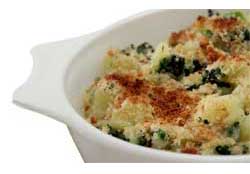 that's
hard to beat! In one dish, usually assembled ahead of time, the
delicious flavors of key ingredients meld, proving, once again, that
"the whole is greater than the sum of its parts!" In this issue we
refresh our understanding of casseroles, explore bakeware that will
make your dishes flourish in so many ways, and provide a quick review
of heat protection in the kitchen. We feature James Villas' cookbook, Crazy for Casseroles, and three of its recipes that are within reach of every cook and will turn anyone into a casserole connoisseur! that's
hard to beat! In one dish, usually assembled ahead of time, the
delicious flavors of key ingredients meld, proving, once again, that
"the whole is greater than the sum of its parts!" In this issue we
refresh our understanding of casseroles, explore bakeware that will
make your dishes flourish in so many ways, and provide a quick review
of heat protection in the kitchen. We feature James Villas' cookbook, Crazy for Casseroles, and three of its recipes that are within reach of every cook and will turn anyone into a casserole connoisseur!
|
Special Le Creuset Feature
|
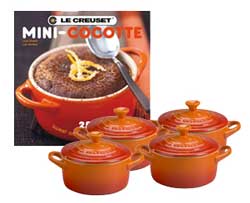
To celebrate the heritage color, Flame, Le Creuset is offering
this Limited Edition Set of
4 Mini Cocottes in the iconic shade of orange. For a limited time,
purchase the Set of 4 Cocottes and receive a bonus cookbook dedicated to the
great features and benefits of the Mini Cocotte. Perfect for gift giving, this
set of 4 comes in a beautifully packaged hat box with
lid.
This brand new cookbook from Le
Creuset features 25 specially created recipes just for the Mini Cocotte and its
versatile cooking and serving features. Classic recipes including French Onion
Soup, Chicken Pot Pie and Macaroni and Cheese are featured throughout the fully
illustrated hard cover cookbook. Set w/ cookbook: $80.00.
While supplies last. |
|
|
|
Anniversary Sale - Sep 10, 11, 12
|
 |
Concocting Casseroles
|
Even
when casseroles had temporarily lost their public flair, they were
always at home in the everyday kitchen. Now back in the limelight, the
casserole graces buffets spreads, dinner parties, and elegant dining
tables in some form. Broadly defined, a casserole is a one-dish meal
baked in an oven. From there, variations abound!
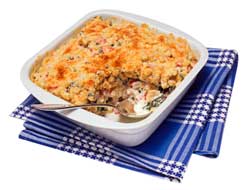 Casserole Cousins
- Some claim casseroles to be a distinctly American invention, but
hundreds of baked dishes exist across many cultures. Our persistent
interest in other regional and international cuisines has opened us up,
once again, to casseroles. We know them, perhaps, by other names:
French Cassoulets, Southern Shroups, Egg Stratas, Seafood Bakes, Pots,
Pot Pies, Vegetable Gratins, Italian Lasagnas and Baked Shells, Greek
Moussakas and Pastistos, Royales, Supremes, Minnesotan Hot Dishes, and
the dessert casseroles, Cobblers, Crisps, Crunches. Casserole Cousins
- Some claim casseroles to be a distinctly American invention, but
hundreds of baked dishes exist across many cultures. Our persistent
interest in other regional and international cuisines has opened us up,
once again, to casseroles. We know them, perhaps, by other names:
French Cassoulets, Southern Shroups, Egg Stratas, Seafood Bakes, Pots,
Pot Pies, Vegetable Gratins, Italian Lasagnas and Baked Shells, Greek
Moussakas and Pastistos, Royales, Supremes, Minnesotan Hot Dishes, and
the dessert casseroles, Cobblers, Crisps, Crunches.
Ultimate Practicality
- The resurgence of casseroles is logical in many respects; they appeal
to a practicality that so easily trumps fussiness. Traditionally, the
casserole was the perfect venue for ready ingredients based on seasonal
availability. Variously composed, the casserole kindly stretched
ingredients to the crowd at hand. Most casseroles can be prepared ahead
of time leaving the kitchen and the cook free and clear for other meal
preparation tasks. Once ready, most casseroles may be eaten with a fork
eliminating carving, cutting and complex serving. The casserole
epitomizes "family-style dining."
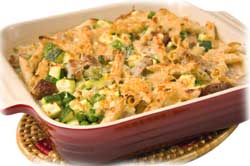 The Ties That Bind
- One-dish concoctions generally use a binder of one sort or another
that builds cohesiveness in the resulting product while adding
distinctive flavor. Classic binders include eggs, cream, sour cream,
roux-based sauces and cheeses. The 50's and 60's homemaker substituted
canned condensed soups as the popular binder; it may be this sub-par
preparation that perhaps eventually led to the casserole's temporary
demise. Back to cooking from scratch, casseroles flourish once again. The Ties That Bind
- One-dish concoctions generally use a binder of one sort or another
that builds cohesiveness in the resulting product while adding
distinctive flavor. Classic binders include eggs, cream, sour cream,
roux-based sauces and cheeses. The 50's and 60's homemaker substituted
canned condensed soups as the popular binder; it may be this sub-par
preparation that perhaps eventually led to the casserole's temporary
demise. Back to cooking from scratch, casseroles flourish once again.
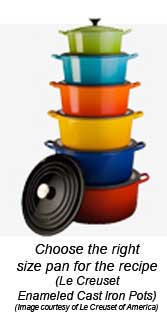 Choosing the Right-Sized Pan
- Most casserole recipes will indicate the size of pan to be used
measured by volume - most commonly a 1.5 quart, 2 quart, 2.5 quart, or
3 quart pan. Be aware that not all same-sized pans are shaped in the
same way. Some pans are shallow, others deep. The shape of the pan will
affect the length of baking time. Shallow pans will bake more quickly;
deeper pans will heat more slowly. Choosing the Right-Sized Pan
- Most casserole recipes will indicate the size of pan to be used
measured by volume - most commonly a 1.5 quart, 2 quart, 2.5 quart, or
3 quart pan. Be aware that not all same-sized pans are shaped in the
same way. Some pans are shallow, others deep. The shape of the pan will
affect the length of baking time. Shallow pans will bake more quickly;
deeper pans will heat more slowly.
When Is It Done?
- Many casserole recipes offer timing instructions such as "bake until
bubbly." Seemingly vague, the instruction is spot on; at the point
where the casserole is bubbly throughout, the temperature is most
likely above 200°F. At that temperature, eggs have coagulated, cream
has thickened, juices evaporated and the mixture begins to set up as
desired.
Friendly Follow-on Food
- Casseroles make for perfect leftovers, if there are any.... Package
leftovers in logical containers for follow-on use; refrigerate or
freeze. Reheat leftovers in the oven or microwave oven. A sprinkling
of water on top of the leftovers and a light cover will keep the
casserole from becoming too dry in the reheating process.
|
Better Bakeware
|
Now
that one-dish baked meals are back, the vessels for baking and serving
have been updated, tempered, and designed for the contemporary kitchen.
Once was the time where the only casserole dish was a clear, glass
rectangular piece; today, the range and diversity of bakeware is
exciting and sports whole new levels of practicality.
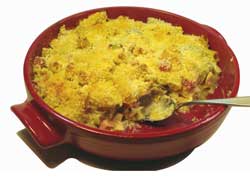 What to Look For in a Baker
- Updating your bakers and casseroles will provide new inspiration for
the genre. Consider the following characteristics when choosing baking
dishes: What to Look For in a Baker
- Updating your bakers and casseroles will provide new inspiration for
the genre. Consider the following characteristics when choosing baking
dishes:
- Material
- Casseroles as a vessel have traditionally been earthenware vessels.
Today's choices are often earthenware in the form of specially
formulated and fired ceramics. Choose bakers that are tempered to move
from freezer to oven to table.
- Durability - Finishes with quality glazes or enameling provide easy cleaning, resist stains and avoid odor retention.
- Shape and Size
- Equip your kitchen with a variety of sizes to make tailoring your
choice of baker and recipe as easy as possible. Too small, or too
large, and your baking will be altered in perhaps undesirable ways.
- Lids
- Many bakers or baking pots come with lids which can be handy for
stovetop preparation, keeping food warm on the way to the table, and
covering leftovers in the refrigerator. Lids are generally not required
during the baking phase, however.
- Handles
- Practice lifting a baker with hot pads in hand to ensure that a good
grip is available. A pan without handle areas is difficult to maneuver
when full and hot.
Our Favorites:
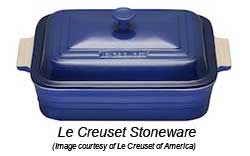 Le Creuset - This French manufacturer of quality bakeware offers two types of pans that are perfect for casseroles. Le Creuset's Stoneware Bakers
feature all of the sought after characteristics of a great casserole
dish. Available in many shapes - square, rectangular, oval, loaf, and
pie - the sizes range from individual servings to crowd-sized vessels
of 5+ quarts. Le Creuset stoneware resists stains, chipping and
cracking. Le Creuset Stoneware is rated for use in situations up to
500°F. Also well-known for their enameled cast iron, Le Creuset
products come in bold, bright colors that complement food and the table
in delightful ways. Le Creuset - This French manufacturer of quality bakeware offers two types of pans that are perfect for casseroles. Le Creuset's Stoneware Bakers
feature all of the sought after characteristics of a great casserole
dish. Available in many shapes - square, rectangular, oval, loaf, and
pie - the sizes range from individual servings to crowd-sized vessels
of 5+ quarts. Le Creuset stoneware resists stains, chipping and
cracking. Le Creuset Stoneware is rated for use in situations up to
500°F. Also well-known for their enameled cast iron, Le Creuset
products come in bold, bright colors that complement food and the table
in delightful ways.
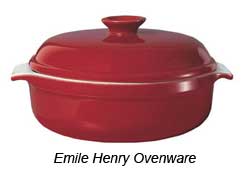 Emile Henry
- Another French-based company, Emile Henry uses clay from the Burgundy
region of France to craft its ceramic pieces. The nature of this
special ceramic slowly and evenly transfers heat throughout dish. Once
heated, the ceramic holds the heat beautifully keeping the food hot
until the second helpings are had. Possessing extraordinary "thermal
shock" properties, Emile Henry products move directly from freezer to
oven, and are at home in the microwave and under the broiler. Emile Henry's Flametop® series
has the added ability of stovetop functionality. These products are
stain resistant, do not crack or chip easily, and have glazes that will
not craze or discolor with use. Explore the new Emile Henry colors! Emile Henry
- Another French-based company, Emile Henry uses clay from the Burgundy
region of France to craft its ceramic pieces. The nature of this
special ceramic slowly and evenly transfers heat throughout dish. Once
heated, the ceramic holds the heat beautifully keeping the food hot
until the second helpings are had. Possessing extraordinary "thermal
shock" properties, Emile Henry products move directly from freezer to
oven, and are at home in the microwave and under the broiler. Emile Henry's Flametop® series
has the added ability of stovetop functionality. These products are
stain resistant, do not crack or chip easily, and have glazes that will
not craze or discolor with use. Explore the new Emile Henry colors!
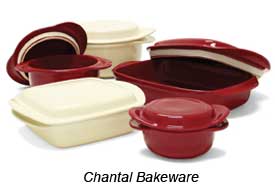 Chantal - A U.S.-based company, Chantal is well-known for its enamel-on-steel products, Copper Fusion™ cookware, and now, its Make and Take® Bakeware.
Chantal bakeware features all manner of shapes and sizes in beautiful
ceramic and stoneware colors and moves easily from oven to table. The
lids of the new Make and Take® line sport a removable silicone gasket
that form a seal for safe transport and secure refrigerator storage. Chantal - A U.S.-based company, Chantal is well-known for its enamel-on-steel products, Copper Fusion™ cookware, and now, its Make and Take® Bakeware.
Chantal bakeware features all manner of shapes and sizes in beautiful
ceramic and stoneware colors and moves easily from oven to table. The
lids of the new Make and Take® line sport a removable silicone gasket
that form a seal for safe transport and secure refrigerator storage.
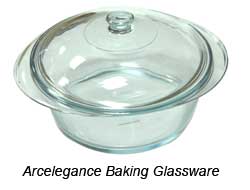 Arcelegance - Also from France, Arcuisine manufactures clear glass ovenware, Arcelegance,
designed to withstand thermal and mechanical shock. Simple and elegant,
the glass pieces come in oval and rectangular shapes and matching lids.
Great for its see-through character. Arcelegance - Also from France, Arcuisine manufactures clear glass ovenware, Arcelegance,
designed to withstand thermal and mechanical shock. Simple and elegant,
the glass pieces come in oval and rectangular shapes and matching lids.
Great for its see-through character.
Soufflés and Ramekins
- Available in many brands, shapes and sizes, these classic fluted-edge
baking dishes with their straight-sides are ideal for casseroles of all
types.
|
Heat Defense Systems
|
It's
a daily threat in the kitchen - protecting oneself and one's
environment from the damages of misplaced heat. The gift of heat that
allows us to eat a greater range of foods, also has the potential to
burn or scar our skin, countertops, and dining room tables.
Understanding heat transfer and its affects on surfaces helps us avoid
damage and pain.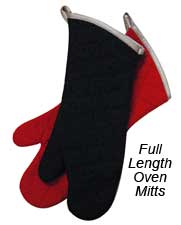
What is Heat?
- Heat is a form of energy, thermal energy that moves from one object
to another. In the kitchen, heat transfer occurs when objects are in
contact with each other. Nature favors equalization of temperatures
between the objects. The speed at which this equalization happens is
based on the molecular characteristics of the objects. Some materials
are great conductors of heat, (i.e., metal, liquids), others are
insulators (glass, wood).
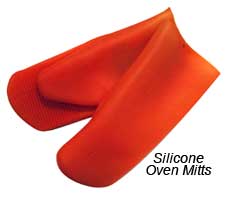 Cloth Protection
-- In the kitchen, hot pads and oven mitts are indispensable in
providing protection particularly when moving food out of the oven. The
traditional material for hot pads and oven mitts is cotton fabric.
Cotton or cotton blends have the characteristic of withstanding higher
temperatures. Wool, also an excellent heat resistor, is not quite as
washable as cotton. Oven mitts provide full protection in and around
the oven. Cloth Protection
-- In the kitchen, hot pads and oven mitts are indispensable in
providing protection particularly when moving food out of the oven. The
traditional material for hot pads and oven mitts is cotton fabric.
Cotton or cotton blends have the characteristic of withstanding higher
temperatures. Wool, also an excellent heat resistor, is not quite as
washable as cotton. Oven mitts provide full protection in and around
the oven.
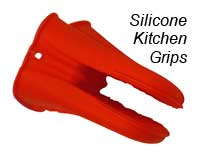 Silicone Innovation
- The advent of silicone-based products throughout the kitchen has also
provided some novel application of the materials in the heat protection
arena. Silicone is very heat resistant, exceptionally flexible, and
easy to clean. Investigate silicone oven mitts, handles, and trivets. Silicone Innovation
- The advent of silicone-based products throughout the kitchen has also
provided some novel application of the materials in the heat protection
arena. Silicone is very heat resistant, exceptionally flexible, and
easy to clean. Investigate silicone oven mitts, handles, and trivets.
Other Natural Insulators
- In addition to plant-based fabrics, other plant materials, wood and
cork, prove to be excellent insulators and heat protectors. A
decorative cutting board or cork trivet will host your hot casserole
dish safely.
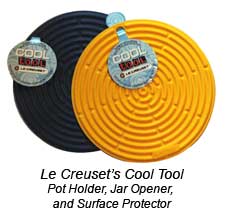 Countertops and Dining Surfaces
- Your kitchen countertop may be sensitive to the heat. A laminate
surface is most sensitive and can easily be scarred from a hot
casserole dish. Solid surfaces, like Corian® or similar products, are
less sensitive, but still susceptible. Manufactured stone is also
sensitive to heat. Granite, marble, limestone, and concrete are less
susceptible to heat, though the sealers placed on these surfaces may be
sensitive to heat. Stainless steel is the least sensitive to heat
though abrupt localized changes in the metal's temperature may cause
temporary reactions. Bottom line, protect your countertop surfaces by
insulating them from heat sources. Countertops and Dining Surfaces
- Your kitchen countertop may be sensitive to the heat. A laminate
surface is most sensitive and can easily be scarred from a hot
casserole dish. Solid surfaces, like Corian® or similar products, are
less sensitive, but still susceptible. Manufactured stone is also
sensitive to heat. Granite, marble, limestone, and concrete are less
susceptible to heat, though the sealers placed on these surfaces may be
sensitive to heat. Stainless steel is the least sensitive to heat
though abrupt localized changes in the metal's temperature may cause
temporary reactions. Bottom line, protect your countertop surfaces by
insulating them from heat sources.
|
Smart Casserole Tips
|
Tip #1:
Use a meat thermometer to check the temperature of your casserole.
Sometimes the edges may be bubbling away, but the center remains
lukewarm and liquefied. Checking the temperature periodically at the
center allows a progress check and timing assessment.
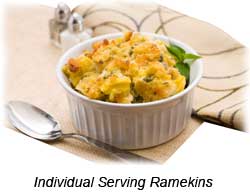 Tip #2:
Class up your table presentation of baked dishes with individual
casseroles or ramekins. Serve these single servings on a separate plate
lined with a simple doily or cloth napkin. Check out Le Creuset's
Mini-Cocottes in their iconic shade of orange. Tip #2:
Class up your table presentation of baked dishes with individual
casseroles or ramekins. Serve these single servings on a separate plate
lined with a simple doily or cloth napkin. Check out Le Creuset's
Mini-Cocottes in their iconic shade of orange.
Tip #3:
Generally, if your baker is built for moving directly from freezer to
oven, place the frozen pan in a cold oven and allow the pan to preheat
along with the oven. The center of a frozen casserole will take longer
to bake than an unfrozen casserole. Adjust your timing accordingly.
Tip #4:
At the risk of stating the obvious, know where you're going with the
hot casserole before opening the oven door. We've all done it; in our
rush to get the dish out of the oven, we forget to find a landing
space. Clear a safe location, protect the surface, then
transfer the casserole from the oven. Hot pads will protect your hands
for only a short time, plan to transfer quickly. Keep your hot pads and
mitts dry -- water is a very effective conductor of heat!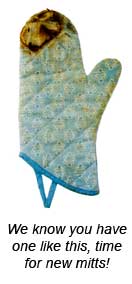
Tip #5:
Casseroles are often topped with cheese or a breaded topping. We think
panko bread crumbs are particularly good as a casserole topping.
Drizzle melted butter on the crumbs and toss until incorporated. Spread
evenly on the casserole's top.
Tip #6:
Use an old trick to track your baking dishes. On the inside of a
kitchen cupboard, tack a card listing your favorite baking dishes and
their sizes, e.g., large blue baker = 1.5 quarts, red round = 2 quart,
and so on. You'll reach for the right size more easily while keeping
track of some less used pieces.
Tip #7:
These 'tween days between air conditioners and furnaces where our homes
are naturally more open are a great time to flip on the self-cleaning
mode of your oven. The open windows will provide the necessary
ventilation for the high temperature cleaning process.
|
Q & A's
|

Q: How did Campbell's soups become so associated with American casseroles?
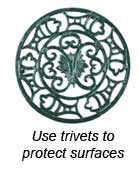 A:
In the 1950's, marketing efforts by the soup company enticed homemakers
to buy their products by providing recipes utilizing their prepared
soups. Perhaps the most famous incarnation of this phenomenon is the
still popular Green Bean Casserole. According to the Campbell Soup
Company, the recipe was developed in their test kitchens in 1955 by
Dorcas Reilly as a combination of French cut green beans, condensed
mushroom soup, and French-fried onions. A:
In the 1950's, marketing efforts by the soup company enticed homemakers
to buy their products by providing recipes utilizing their prepared
soups. Perhaps the most famous incarnation of this phenomenon is the
still popular Green Bean Casserole. According to the Campbell Soup
Company, the recipe was developed in their test kitchens in 1955 by
Dorcas Reilly as a combination of French cut green beans, condensed
mushroom soup, and French-fried onions.
Q: What's the best way to clean ceramic bakers?
A:
Most food remains can be cleaned easily from well-glazed bakers. For
burnt or stuck-on foods, simply allow the baker to soak in hot, soapy
water for a period. The excess food will easily wash away after a good
soak. Avoid immersing stoneware in water for long periods of time.
Q: How can I tell what the size of my baking dish is?
A:
Most U.S. recipes express the size of the casserole in "quarts." Check
the bottom of your baking dish to see if the size is inscribed on the
bottom. If it is not, measure the volume of the dish by pouring
measured water into the baker to a height one-half inch from the rim. 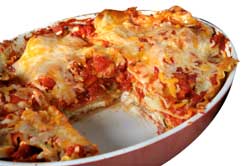 The amount of water used will approximate the recipe volume that the dish will hold. The amount of water used will approximate the recipe volume that the dish will hold.
Q: How can I keep my casserole from bubbling over in the oven and making a mess?
A:
Choose the right size of baking dish for the recipe. Fill the dish
leaving at least an inch of space from the top of the rim. This should
contain the most exuberant of bubbling casseroles. Just in case, oven
liners can minimize the work of an oven mess.
|
|
Cookbook Review
|
Crazy for Casseroles, 275 All-American Hot-Dish Classics by James Villa. Copyright 2003. Published by Harvard Common Press, Boston, MA.
A James Beard Foundation Book Award Nominee
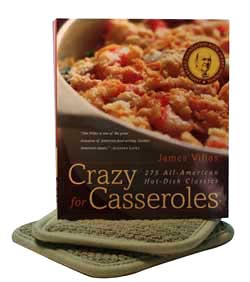 This
accomplished cookbook author puts it all together for us in this hefty
cookbook. Based in a love for capturing the best of regional cooking,
Mr. Villas has assembled a tome of recipes that preserves some of the
best of our cooking heritage while greatly expanding today's
possibilities for the casserole by incorporating fresh ingredients and
novel combinations. His offering is organized first by course:
appetizers, entrées, sides, breads and desserts. Within each category,
he surveys the full range of possibilities by primary ingredient, eggs,
meats, poultry, fish, pasta, vegetables and fruits. We appreciated his
chapter on "Casseroles for a Crowd" where we were tutored through some
of the nuances of large quantity cooking. We're grateful to Mr. Villas
who in this book, has resurrected and reestablished the casserole as a
rich culinary tradition both classic and contemporary. This
accomplished cookbook author puts it all together for us in this hefty
cookbook. Based in a love for capturing the best of regional cooking,
Mr. Villas has assembled a tome of recipes that preserves some of the
best of our cooking heritage while greatly expanding today's
possibilities for the casserole by incorporating fresh ingredients and
novel combinations. His offering is organized first by course:
appetizers, entrées, sides, breads and desserts. Within each category,
he surveys the full range of possibilities by primary ingredient, eggs,
meats, poultry, fish, pasta, vegetables and fruits. We appreciated his
chapter on "Casseroles for a Crowd" where we were tutored through some
of the nuances of large quantity cooking. We're grateful to Mr. Villas
who in this book, has resurrected and reestablished the casserole as a
rich culinary tradition both classic and contemporary.
|
|
Recipes for Delicious Casseroles
|
Recipes excerpted from Crazy for Casseroles
by James Villa. Copyright 2003. Published by Harvard Common Press,
Boston, MA. Used with permission of the publisher. All rights reserved.
Sunday Sausage, Apple, and Cheese Strata
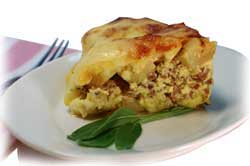 This
breakfast or brunch casserole is a nice twist on traditional egg hot
dishes. The sausage (we recommend a spicy choice), provides a
satisfying heft, the apples a slight sweetness, and the cheese produces
a melted wonderfulness. Pair this with fresh fruit cup and call it the
perfect start to a day! This
breakfast or brunch casserole is a nice twist on traditional egg hot
dishes. The sausage (we recommend a spicy choice), provides a
satisfying heft, the apples a slight sweetness, and the cheese produces
a melted wonderfulness. Pair this with fresh fruit cup and call it the
perfect start to a day!
Click here to view the full recipe.
Click here for a printable version of the recipe.
Potato, Wild Mushroom, and Sorrel Gratin
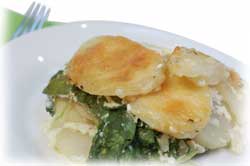 Reminiscent
of scalloped potatoes, but two leaps past, this gratin exceeds
expectations on the flavor scale. The season's fresh harvest of
potatoes is perfect for this dish! We were all out of sorrel but
followed the recommendation to substitute arugula. The woodsy flavor of
the mushrooms offered distinctive flavors to the experience. Reminiscent
of scalloped potatoes, but two leaps past, this gratin exceeds
expectations on the flavor scale. The season's fresh harvest of
potatoes is perfect for this dish! We were all out of sorrel but
followed the recommendation to substitute arugula. The woodsy flavor of
the mushrooms offered distinctive flavors to the experience.
Click here to view the full recipe.
Click here for a printable version of the recipe.
David's Chicken, Ham, Artichoke, and Pasta Casserole
 We
second the author's introduction of this dish as an "up-to-date. . .
sophisticated casserole." Once again, the flavors blended into a
delectable dish, just as a casserole should. The slight smokiness of
the ham, the artichokes, and the Parmesan cheese characterized the
final product that we savored bite by bite as we enjoyed our white
wine, sip by sip. We
second the author's introduction of this dish as an "up-to-date. . .
sophisticated casserole." Once again, the flavors blended into a
delectable dish, just as a casserole should. The slight smokiness of
the ham, the artichokes, and the Parmesan cheese characterized the
final product that we savored bite by bite as we enjoyed our white
wine, sip by sip.
Click here to view the full recipe.
Click here for a printable version of the recipe.
|
 |
What's old, is forever new - true for casseroles, too!
|
|
Lorraine, Katie, and all of the Staff at Beyond Pots and Pans
|
|
|
|
|